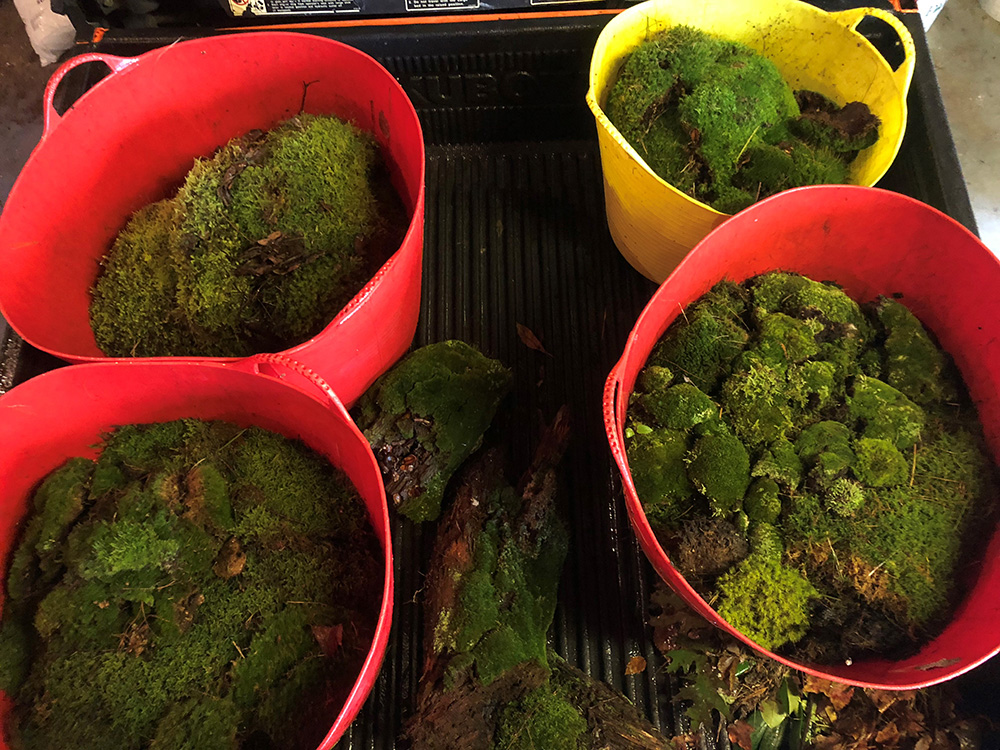Naturalizing Moss: Report
Project: Reclaim a 400 square foot shady hillside lined with Japanese Maples and other low growing perennials and shrubs. The desired aesthetic is for all soil to be covered in a solid sheet of moss. Efforts to cultivate moss in the past had been attempted but were unsuccessful.
Choosing moss: We found a huge variety of moss growing wild in wooded areas surrounding the cultivated gardens. Mosses were selected based on their size and appearance. We tried to select specimens growing in conditions that were analogous to the conditions they were being placed. On our various excursions we gathered an abundance of different mosses. Some of the varieties we were able to identify are:
Pincushion moss : Leucobryum glaucum grows in dense clump forming mounds that range in size from 1-2 inches to over 3 feet in diameter. The clumps absorb and retain water and produce root-like structures from the terminal leaf from which new clusters begin growing. These mosses primarily sit on the surface of the soil and are easily gathered. Pincushion moss prefers shade or part sun, acidic soil of all types, and can tolerate dryer conditions than most other moss types.
White cushion moss; Leucobryum glaucum: Identical growth and environmental demands as pincushion moss, but the terminal leaves do not produce chlorophyll and appear white at the tips.
Sheet mosses: Hypnum Curvifolium, Hypnum Imponens: Part sun/shade. Well drained or sandy acidic soil. Prefers dryer conditions, particularly H.imponens. Grows in large sheets with feather like leaves.
Reindeer moss: Cladonia rangiferina: Not truly a moss but a type of lichen. Very striking light green/blue. Is highly branched and grows in a wide range of climates preferring well drained, open environments. Very slow growing. Will grow in hummusy, or rocky soils.
Funaria hygrometrica: We have a large swath of established funaria hygrometrica that thrives in moist conditions. It has created a solid carpet on the side of the path where it has flourished
Common Fern Moss;Thuidium delicatulum: Fern moss prefers partial sun to shade, acidic soil or humus, and wet to moist conditions. This evergreen moss forms a loose mat of golden to green colored double or triple-pinnate leaves.
Tree Skirt Moss; Anomodon attenuatus: Tree skirt moss prefers light to medium shade, semi moist- dry conditions. Will tolerate most types of soils.
Bryum caespiticium– sun loving moss that turns a dark emerald green when wet. Once established can tolerate being completely dried out. Makes a great addition to full sun patios or walkways.
Gathering and Transplanting Moss: We went moss gathering throughout the season, primarily on rainy or overcast days. We began with the plan to transplant a small swath of moss early in the season to see if it would survive. Encouraged by the success of the small patch, we began gathering larger quantities of various types of moss. When gathering mosses from the wild, we were very mindful not to harvest the entirety of a particular moss type leaving approximately ⅓ of the piece we were harvesting to allow for repopulation the following year. Most mosses were easily scraped from their substrates with a hori hori knife or a flat spade. To transplant the moss we gathered, we scored the surface of the soil, and gently arranged the clumps in an aesthetically pleasing fashion. Our goal was to have the instant effect of an established moss covered hillside, so we placed the transplants fairly close together. Our rationale in gathering a variety of mosses, apart from the aesthetic interest of different colors and textures, was to see what types work best in the area we were planting, thus informing future foraging. We transplanted both full sun and deep shade varieties of moss to correspond with differing exposures of the area.
Protecting the Transplants: as moss do not produce roots in the same sense as perennials, we took extra measures to prevent excessive foot traffic and disturbance from rodents and birds. We laid mesh down and fixed it to the ground with yard staples. This was highly effective for keeping the freshly placed moss in position, but made it slightly more difficult to remove debris as the season progressed to fall. Overall, the appearance was acceptable and was fit for the task of keeping our new transplants undisturbed.
Conclusion: A successful project. We fully naturalized a 400 square foot hillside where moss wouldn’t previously grow. Protecting the moss with mesh was definitely beneficial and certainly increased the chances of establishment while not a distraction visually. While newly transplanted moss benefits from regular misting and watering, certain varieties we transplanted were over watered; specifically the sheet mosses Hypnum Curvifolium/Hypnum Imponens. They clearly preferred a dryer habitat and were the first to exhibit signs of stress in the form of browning out. The other varieties we gathered seemed to take the regular waterings well and began showing signs of establishment. A more moderate approach to watering fresh transplants will be taken in future projects. We began transplanting full sun moss later in the season. The full sun moss was successful in higher areas with absent of shade. Lower spots where run-off accumulates, proved to be too wet for the variety transplanted. As the moss garden continues to establish we will undoubtedly become more strategic with moss choices, however, we are optimistic about the results of our first large scale moss transplanting project.




